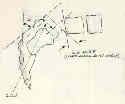
- Types of Spondylolisthesis:
- Congenital
- Isthmic
- Degenerative
- Spondylolysis of the Fourth Lumbar Vertebra
- Spondylolisthesis w/ Scoliosis
- Discussion:
- spondylolysis involves defect passing between superior articular process & remainder of the lamina, most often involving L5;
- when condition is bilateral, superior articular processes are attached to the body by pedicles, but most of the lamina, spinous
process, and inferior articular processes are detached;
- as consequence of defect, body of involved vertebra may displace anteriorly (spondylolisthesis).
- scoliosis is common w/ spondylolysis but herniation of the nucleus pulposus rarely accompanies spondylolisthesis in children;
- diff dx:
- Exam:


- Radiographs:
- x-rays are taken in the stading position to accentuate slippage;
- slip angle: most useful measurement in predicting the likelihood of progression;
- Grade I: (see: occult spondylysis)
- Grade II:
- Grade III and IV:
- Slip Angle;
- Bone Scans
- Treatment:
- Grade I:
- Grade II:
- surgery is reserved for patients w/ intractable pain who have failed non-operative treatment, or w/ progressive deformity;
- treatment involves L5-S1 posterolateral fusion in situ;
- Grade III and IV:
- high risk of L5 nerve root impingement;
- treatment involves arthrodesis from L4 to S1;
- Reduction:
- Decompression:
- as noted by Carragee (1997), the addition of decompression to the posterolateral arthrodesis may actually increase the rate of
pseudoarthrosis and the rate of clinical failure;
- reference:
- Single-level posterolateral arthrodesis, with or without posterior decompression, for the treatment of isthmic spondylolisthesis in adults. A prospective, randomized study.
- References:

